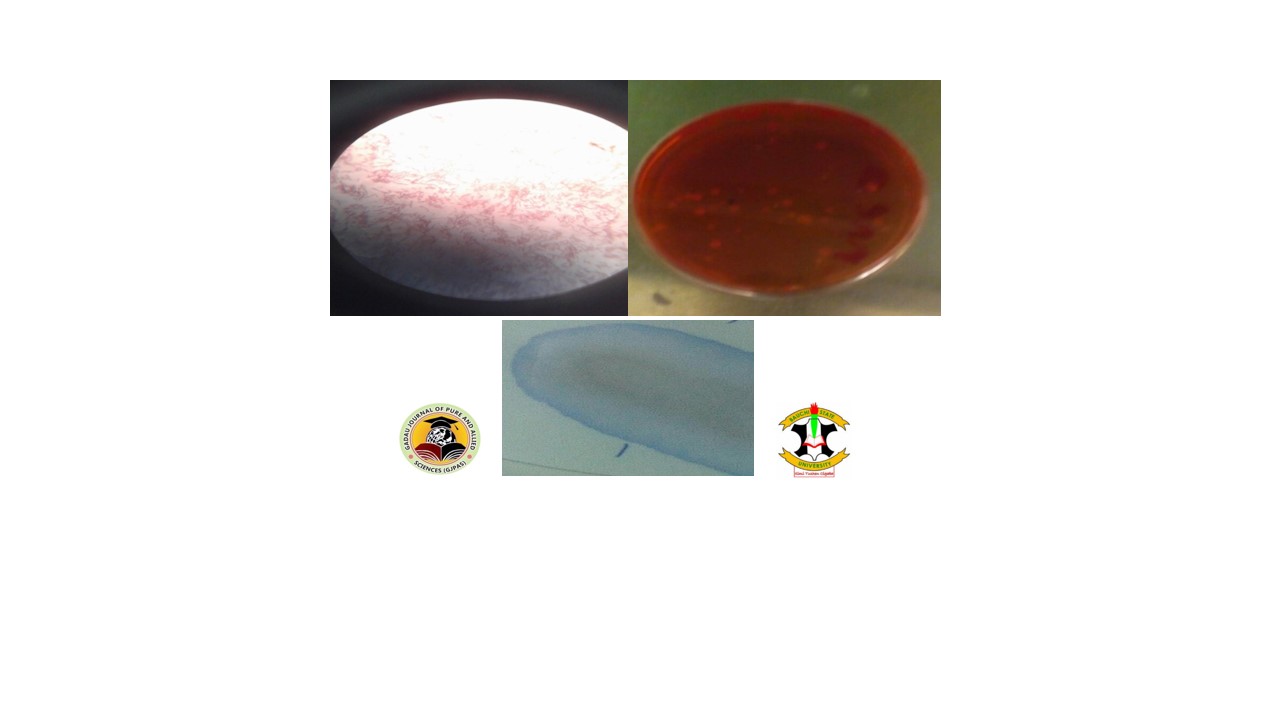Bacteriological assessment on ready-to-eat salad sold in some fast food centers in Azare town, Bauchi State, Nigeria
DOI:
https://doi.org/10.54117/gjpas.v1i1.23Keywords:
Ready-To-Eat, Salad, Bacteriological Assessment, Pathogenic micro-organisms, Escherichia coli, Staphylococcus aureus, FoodAbstract
Eating food that is contaminated by bacteria is one of the main reasons for food poisoning. Food poisoning can be caused by several bacterial species that are present on the raw vegetables and fruits and also in the dairy products that are used in the salad dressings and toppings. This study was carried out to isolate and identify pathogenic micro-organisms associated with ready-to-eat salads obtained from selected fast food centers in Azare town of Bauchi State, Nigeria. Samples of salads were collected from randomly selected locations within the town and subjected to microbial culture in Nutrient and MacConkey agar media for isolation of bacteria. Three bacterial species were isolated, namely; Salmonella Spp, Escherichia coli and Staphylococcus aureus. The total colony count ranged from 3.01x101 cfu/g to1.5x 103 cfu/g respectively. The order of increasing colony count of bacteria isolated was Salmonella Spp, E. coli, and Staphylococcus aureus. The results from the studies showed that ready-to-eat salads samples obtained from the fast food centers have high microbial load and as such do not meet bacteriological standards. Therefore, consumption of such products may pose public health problem. It is therefore recommended that the total hygiene and sanitary conditions under which those fast foods centers operates should be monitored by the relevant Government agencies and stringent supervision of processing methods are applied.
References
Adebayo-Tayo, B.C., Onlude, A.A., Ogunjobi, A.A. (2006). Bacteriological and proximate analysis of periwinkle from two different creeks in Nigeria. World Applied Science Journal 1(2): 87-91.
Adesiyun, A.A, Umoh, J.U, Mosimabale, F.O kwaga, J.K.P, Dusai, D.H.M, Okolocha, E.C, Ajogi, A.I, Dzikwi, A.A, Egege, S.C, Oni, O.O, Lombin, L.H, Ezeifeka, G.O, Luga, I, Kabir, J. (2005). Manual for clinic in veterinary public Health and Preventive Medicine. Ahmadu Bello University, Zaria. ABU press limited. p11-14.
Adesiyun, A.A. (1995). Bacteriological quality of some Trinidadian ready-to-eat foods and rinks and possible health risk to consumers. Journal for Food Protection. 58(3): 651- 655.
Beuchat, L. R. (2006). Vectors and Conditions of Pre-harvest Contamination of Fruits and Vegetables with Pathogens Capable of Causing Enteric Diseases. British Food Journal. 108 (1): 38-53.
Bibek, R. (2005). Fundamental Food Microbiology, CRC Press. London. p 625.
De Roever, C. (1999). Microbiological safety evaluations and recommendation on fresh produce. Journal for Food Control. 9: 321-347.
Dolores, G.E., Doyle, J.G. (2001). Escherichia coli in diarrhea disease. Annual.International Medicine. 247: 81-90.
Donnenberg, M.S., Mandel, G.L., Bemet, J.E., John, R., Mandel, D. (2005). Enterobacteriaceae Principles and Practices of Infectious Diseases. 6th Ed., pp. 267-286.
Fang, T.K., Chen, C.Y., Kuo, W.Y. (1999). Microbiological Quality and Incidence of Staphylococcus aureus and Bacillus cereus in Vegetarian Food Products. Food Microbiology. 16: 385-391.
Halablab, M.A., Sheet I.H. and Holail, H.M. (2011). Microbial quality of raw vegetables grown in Bekaa valley, Lebanon. American Journal of Food Technology. 6: 129-139.
Ibrahim, H., Moshood, A.Y., Tengku, H.A. (2013). Isolation and identification of Bacteria associated with balangu (roasted meat product) sold in Bauchi, Nigeria. IOSR Journal for Pharmaceutical Microbiology. 2(6): 38-48.
James, J.B. and Ngarmsak, T. (2011). Processing of fresh cut tropical fruits and vegetables: A technical guide. FAO, Bangkok, p 102.
Johannessen, G.S., Loncarevic S. and Kruse (2002). Bacteriological analysis of fresh produce in Norway. International Journal of Food H. Microbiology. 77: 199-204.
Mensah, P.D., Yeboah-Manu, K., Owusu-Darko S. and Ablordey, A. (2002). Street foods in Accra, Ghana: How safe are they? WHO Bulletin. 80: 546-554.
Okonko, I.O., Donbraye, E., Babatunde, S.O. (2009). Microbiological quality of Seafood processors and water used in two different sea processing plant in Nigeria. EJEAF che 8(8): 621-629.
Pesewu, G. A., Gyimah, I. K., Agyei, J. N. Y. K., Adjei, D. N., Olu-Taiwo, M. A., Asmah, R. H., and Ayeh-Kumi, P. F. (2014). Bacteriological Assessment of the Quality of Brassica oleraceavar. Capitata Grown in the Accra Metropolis, Ghana. African Journal of Microbiology. Res. 8 (22): 2223-2228.
Rajvanshi, A. (2010). Bacterial Load on Street Vended Salads in Jaipur City, India. Internet Journal for Food Safety. 12: 136-139.
Taban, B. M., and Halkman, A. K. (2011). Do Leafy Green Vegetable and Their Ready-to-eat (RTE) Salads Carry a Risk of Food borne Pathogens? Anaerobe. 17(6): 286-287.
Tortora, G. (1995). Microbiology, The Benjamin Publishing Co. Inc. New York. p 532.

Downloads
Published
Issue
Section
License
Copyright (c) 2022 Gadau Journal of Pure and Allied Sciences

This work is licensed under a Creative Commons Attribution 4.0 International License.

